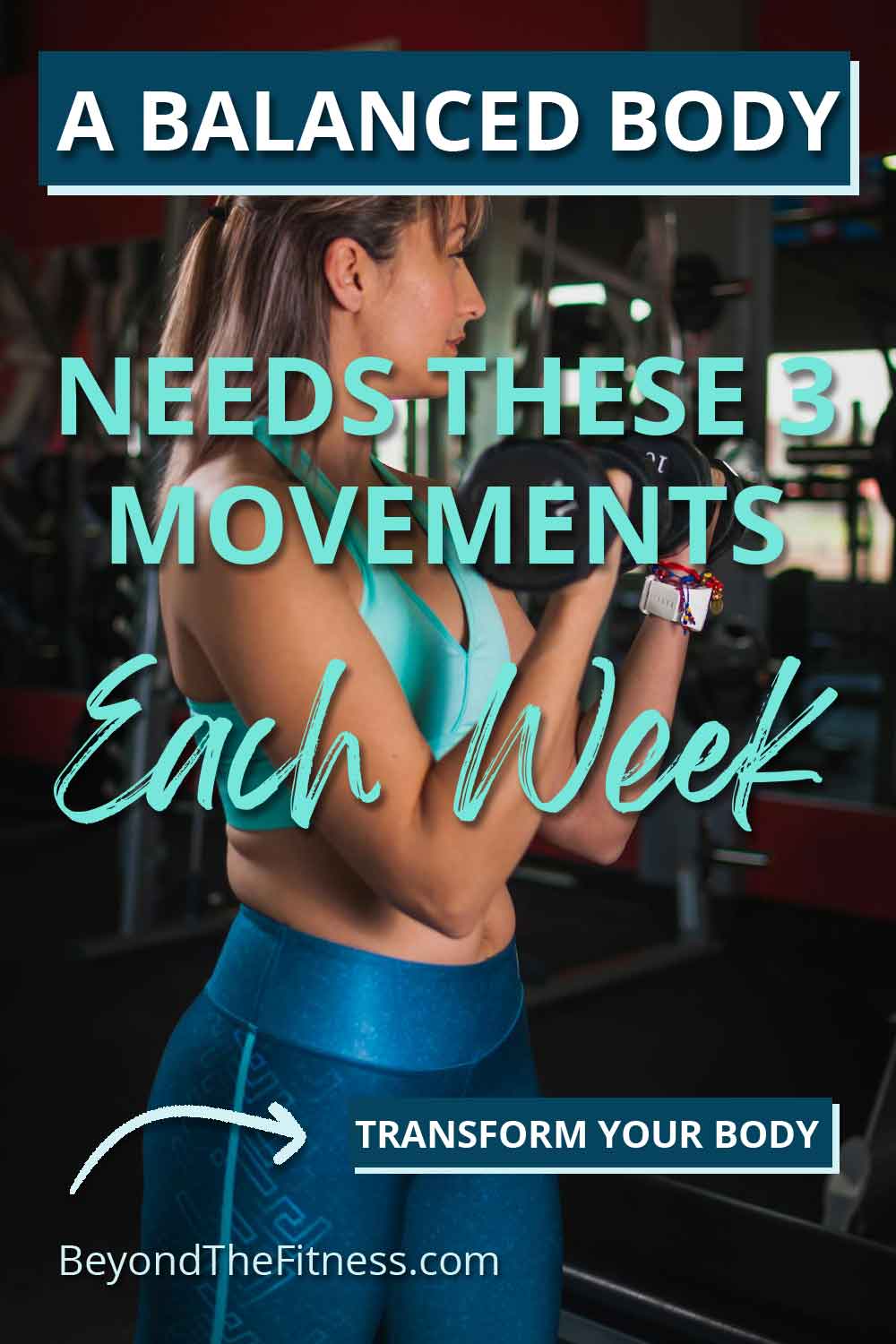When it comes to staying healthy and feeling great, getting in the right types of movement is just as important as the amount of movement. It’s easy to think that doing the same exercise over and over will work, but our bodies thrive on variety. The good news? You don’t need to spend hours at the gym every day to see results.
By focusing on three types of movement each week, you can build strength, improve your heart health, and keep your body flexible and injury-free. Here’s what I’ve learned about how to structure these workouts and why they’re so important for every woman.
Strength Training: Building a Strong Foundation
Strength training isn’t just about lifting weights or trying to bulk up. It’s about making your muscles stronger so they can support your body and help you move better.
Why Strength Training Matters
When I started strength training, I noticed that my daily tasks, like carrying groceries or playing with my kids, felt easier. Strength training helps build muscle, which is important because women naturally lose muscle as we age. More muscle also means burning more calories, even when we’re resting.
How to Add Strength Training to Your Week
You don’t need fancy equipment to start. I love using dumbbells, resistance bands, or even just my body weight. Here are some exercises to try:
- Squats: Strengthen your legs and glutes.
- Push-ups: Work your chest, arms, and core.
- Planks: Build core strength and stability.
- Lunges: Great for balance and leg strength.
I aim to do strength training two times a week for about 30 minutes. Focus on working all your major muscle groups, and don’t be afraid to increase the weights or resistance over time.
Cardio: Keeping Your Heart Happy
Cardio might sound intimidating, but it’s really about getting your heart pumping. It’s one of the most important types of movement for staying healthy.
Why Cardio Is a Must
Cardio strengthens your heart and lungs, helps you burn calories, and boosts your energy levels. For me, it’s also a great way to improve my mood. After a good cardio session, I feel more focused and less stressed.
Fun and Simple Ways to Do Cardio
Cardio doesn’t have to be boring or complicated. Here are some of my favorite ways to get moving:
- Walking or jogging: A brisk walk can do wonders for your heart.
- Dancing: Put on your favorite playlist and dance around your living room.
- Cycling: Whether it’s a stationary bike or riding outdoors, this is a great low-impact option.
- Jump rope: It’s simple, fun, and an excellent workout.
I recommend aiming for 150 minutes of moderate cardio each week, which breaks down to about 30 minutes, five days a week. If you’re short on time, you can go for 75 minutes of more intense cardio, like running or high-intensity interval training (HIIT).
Flexibility and Mobility: Staying Loose and Injury-Free
I used to skip stretching because it didn’t feel like a real workout. But when I started focusing on flexibility and mobility, I noticed fewer aches and pains and better posture.
Why Flexibility and Mobility Matter
Stretching and mobility exercises help improve your range of motion, reduce stiffness, and lower the risk of injury. For me, they’re also a way to unwind and relax after a busy day.
Easy Ways to Improve Flexibility and Mobility
You don’t need to be a yoga pro to work on flexibility. Here’s what I like to do:
- Yoga or Pilates: These workouts combine stretching with strength and balance.
- Dynamic stretches: Moves like leg swings or arm circles warm up your muscles before a workout.
- Static stretches: Hold stretches like a seated forward fold after your workout to release tension.
I try to include 10–15 minutes of stretching or mobility work after each workout. It’s also helpful to dedicate one day a week to a full yoga or Pilates session.
Creating Your Weekly Workout Plan
Balancing these three types of movement doesn’t have to be tricky. Here’s a sample week to help you get started:
- Monday: 30 minutes of cardio (like brisk walking)
- Wednesday: Strength training for 30 minutes
- Friday: 30 minutes of cardio (try cycling or jogging)
- Sunday: Yoga or a stretching session for 20 minutes
You can mix and match based on your schedule. What matters most is that you’re consistent.
When I started focusing on strength, cardio, and flexibility every week, I noticed big changes in how I felt and moved. My body felt stronger, my energy levels soared, and I had fewer aches and pains. These three forms of movement work together to keep your body balanced and healthy.
If you’re new to working out or getting back into a routine, just start small. Even 3 workouts a week can make a difference. As you build confidence, you can add more variety and intensity.
Why Rest Days Are Just as Important
One thing I’ve learned on my fitness journey is that rest days aren’t lazy days—they’re essential for your body to recover and grow stronger. When we work out, especially during strength training or cardio sessions, we put stress on our muscles, joints, and even our nervous system. Rest days give these systems time to repair.
The Science Behind Recovery
When you do strength training, tiny tears form in your muscle fibers. This might sound bad, but it’s actually a good thing! During rest, your body repairs these tears, making the muscles stronger. Cardio workouts can also challenge your heart, lungs, and legs, and they need downtime to rebuild energy stores and prevent burnout.
Without rest days, you’re more likely to feel tired, lose motivation, or even get injured. That’s why I always make sure to include at least one full day of rest in my week.
How to Maximize Rest Days
Rest days don’t mean sitting on the couch all day (although sometimes that’s okay too!). I like to do something light and relaxing to help my body recover. Here are some of my favorite activities:
- Gentle yoga: Focus on deep breathing and light stretches to relax your muscles.
- Walking: A slow, easy stroll is perfect for boosting circulation without overdoing it.
- Foam rolling: This helps release tight muscles and improve recovery.
Nutrition Tips to Support Your Workouts
What you eat plays a huge role in how you feel during and after your workouts. I used to think exercise alone would get me results, but I quickly realized that fueling my body with the right foods is just as important.
You Might Be Interested In: Learning more about The Complete Smoothie Detox & Weight Loss Program
Pre-Workout Fuel
Before a workout, I like to eat something light but energizing. This helps me perform better and keeps me from feeling tired halfway through. Here’s what works for me:
- Banana with peanut butter: A great mix of carbs and a little protein.
- Greek yogurt with berries: Packed with energy and easy to digest.
- Oatmeal with honey: A simple, slow-burning carb source.
I try to eat about 30–60 minutes before exercising so I have enough energy without feeling too full.
Post-Workout Recovery
After a workout, your body needs nutrients to repair muscles and restore energy. My go-to post-workout snacks include:
- Protein shake: Quick and convenient, especially if I’m on the go.
- Grilled chicken with sweet potatoes: A balanced meal that’s filling and satisfying.
- Eggs and whole-grain toast: Great for a post-morning workout breakfast.
Protein is the star here because it helps rebuild muscles. I aim to include 20–30 grams of protein in my post-workout meal or snack.
Staying Hydrated
Hydration is something I used to overlook, but now I know how important it is. Water keeps your muscles working properly and helps prevent fatigue. I make it a point to drink water throughout the day and especially before, during, and after exercise.
If you’re doing a sweaty workout, like cardio or a hot yoga class, consider adding electrolytes to your water. Coconut water or sports drinks can help replace the minerals you lose through sweat.
The Power of Consistency
When I first started working out, I felt like I needed to be perfect to see results. But I’ve learned that consistency is what really matters. Even if I miss a day or two, sticking to my weekly plan most of the time makes all the difference.
Setting Realistic Goals
One of the best things I did for myself was to set small, achievable goals. Instead of aiming to lose weight or run a marathon right away, I started with goals like:
- Doing 3 workouts a week consistently.
- Holding a plank for 30 seconds longer than the week before.
- Drinking more water every day.
Each time I hit one of these goals, it gave me the confidence to aim for something bigger.
Tracking Your Progress
I like to keep track of my workouts and how I feel afterward. This helps me see patterns and stay motivated. You don’t need anything fancy—a notebook or a notes app on your phone works just fine.
Here’s what I like to log:
- The type of workout (strength, cardio, or flexibility).
- How long I exercised.
- How I felt during and after (energized, tired, strong).
Looking back on my progress over time is a great reminder of how far I’ve come.
Common Workout Myths (and What I’ve Learned)
When I started my fitness journey, I heard a lot of advice—some of it helpful, and some of it not so much. Here are a few myths I’ve busted along the way:
Myth #1: You Need to Work Out Every Day
The truth is, your body needs time to recover. Overworking yourself can lead to injuries and burnout. Sticking to 3–5 workouts a week is plenty to see progress.
Myth #2: Cardio Is the Best Way to Lose Weight
While cardio is great for your heart and burns calories, strength training is just as important. Building muscle helps your body burn more calories all day long, even when you’re resting.
Myth #3: Lifting Weights Makes You Bulky
This was one I used to worry about, but I’ve learned that it’s not true. Women don’t have the same levels of testosterone as men, so we don’t build muscle the same way. Strength training has helped me feel toned and strong, not bulky.
How to Stay Motivated
Let’s face it: There are days when working out feels like the last thing I want to do. Here’s how I keep myself motivated:
Find Workouts You Enjoy
Exercise doesn’t have to be a chore. I tried a bunch of different activities until I found ones that I looked forward to. For me, it’s dancing and strength training. For you, it might be hiking, swimming, or something else entirely.
Make It Social
Working out with a friend or joining a fitness class can make exercise feel less like work and more like fun. Plus, having someone to keep you accountable is a big motivator.
Reward Yourself
I like to celebrate my wins, big or small. After sticking to my workout plan for a week, I might treat myself to a new pair of leggings or a relaxing bubble bath.
Listening to Your Body
One of the most important things I’ve learned is to listen to my body. Some days, I have tons of energy and can push myself harder. Other days, I need to take it easy, and that’s okay.
Signs You Might Need a Break
If you’re feeling extra tired, sore, or unmotivated, it could be a sign that your body needs rest. Ignoring these signals can lead to overtraining and even injury.
Adjusting as You Go
Your workout routine doesn’t have to be set in stone. Life happens, and sometimes you need to switch things up. Whether it’s trying a new class, adjusting your schedule, or even taking an extra rest day, flexibility is key.
Adding these insights to your weekly plan can help you make fitness a sustainable and enjoyable part of your life. Remember, every small step you take brings you closer to feeling your best. Let’s keep moving forward, one workout at a time!







